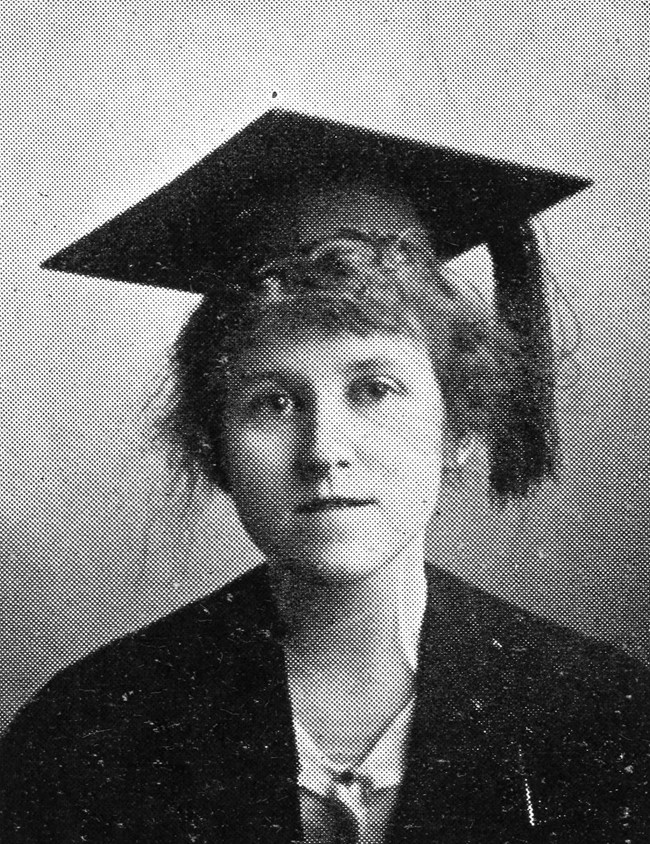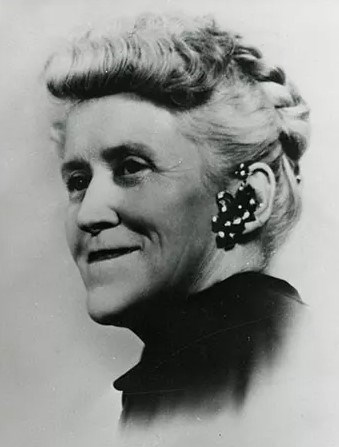Last updated: October 20, 2023
Article
The Winds of Change
The history of women rangers in the National Park Service (NPS) was believed to start with Yosemite and Mount Rainier national parks in 1918, followed by Yellowstone in 1920. New information confirms that Wind Cave National Park, which had a third of the visitors of these other parks in 1917, hired the first woman ranger in 1916 and the second in 1918. Rediscovering these appointments rewrites the history of women in the NPS and challenges the idea that women rangers were only hired due to shortages of men during World War I.
Finding the First Woman Ranger
For a century, the title of first woman park ranger was given to Clare Marie Hodges, who worked at Yosemite National Park in 1918. Staff at Wind Cave National Park quietly challenged that assertion in 2019 by noting on the park website that Esther Brazell gave tours of the cave in 1917, making her the first woman ranger. They pointed to an August 1, 1917, memo that discusses the previous month’s payroll. It notes that Brazell was due $82.50 for her July work. Unfortunately, it doesn’t specify her job title, leaving open the question of the first woman to hold the park ranger title—until now.
Esther L. Brazell was born on May 27, 1896, in Charter Oak, Iowa. She was the daughter of Clara McCain and Thomas W. Brazell, who became supervisor at Wind Cave in August 1914. Esther attended the Spearfish Normal School, graduating in 1916 with the equivalent of two years of college education. Both she and her elder brother Roy followed their father into the NPS. Roy’s career was longer, however, as he succeeded Thomas as superintendent from 1919 to 1928. Meta Alice Kyde Brazell, Roy’s wife, also led tours of Wind Cave in the 1920s but probably in an unpaid capacity.

The park’s June 30, 1917, annual report noted, “During the past summer two park rangers have been employed for guide and general service.” It also reported that “it is the custom for an authorized guide (or guides) to conduct visitors through the cave, and as a trip requires about three hours, but two trips each day are made.”
The lack of men to fill ranger positions due to WWI is frequently cited as the reason women were first given opportunities to work as park rangers. However, the United States didn’t enter the war until April 1917, and therefore it would not have been a factor in Brazell’s appointment in 1916. It’s much more likely that the remoteness of the park coupled with the convenience of her presence, gave her—as it did many later women rangers—the initial foot in the door. Being the boss’s daughter wouldn’t have hurt either. The same advantages applied to her brother, Roy, who was the second ranger hired for the 1916 tourist season.
Esther Brazell’s position in 1916 was authorized until September 30, but her services were terminated on August 31. It’s unclear why, because Roy’s temporary appointment was extended to the end of September, demonstrating a continuing need. It’s possible that she left to teach at Wind Cave School, a job she held in December 1916.
Her father recommended her for an appointment again in May 1917, “as temporary ranger (capacity of second guide).” She entered on duty as a park ranger on June 13, 1917, with a salary increase to $75 per month. The position was due to be terminated on August 31, but she resigned unexpectedly on August 15. Her resignation letter noted, “Upon being advised by the doctor that the climbing of stairs is very detrimental to my health, at this time, I hereby tender my resignation as park ranger.” Roy Brazell was hired as a laborer (at $3 per day) for the rest of August to fill the vacancy created by her resignation. Her work during her period of employment was described as “very satisfactory.”
It’s unlikely that Brazell wore the authorized NPS uniform during her short appointments. An official uniform wasn’t adopted until 1920. Temporary rangers were not required to purchase it until 1923. No photos of Brazell working at Wind Cave have been found.
As the 1918 tourist season approached, her father once again wished to appoint her park ranger, this time at $90 per month. She was to succeed her brother Roy, who was serving in WWI. Expecting an increase in visitation, he sought to hire three rangers for the season. In a telegram, he noted, “none other available who can qualify,” which seems to reflect both the impacts of WWI and the park’s isolation.
This time, however, Assistant Director Horace M. Albright pushed back against her selection. In a letter dated May 16, 1918, he wrote, “It is my understanding that the duties required of Ranger Brazell were of such a nature that he was available for service in practically any capacity in the park. I am not satisfied as to the entire suitability of Esther Brazell for service in such capacity and feel that you should make every effort to secure the employment of a satisfactory man who could be relied upon to handle park affairs in event of your absence or sickness. Please give this matter your careful attention and advise me of the result. If necessary, the Service will pay $100 per month to secure the right kind of service.” Although Mrs. Jessie Foote Jack was custodian of Capulin Mountain (now Volcano) National Monument at the time, Albright’s letter suggests that he didn’t believe a woman could manage a national park in the absence of a man.

Superintendent Brazell responded that “I concur with you in the belief that it will take a man to be available in any and every capacity in the park work” but noted that “conditions are such that had I a ranger, we could not well spare him for guide service, only in emergencies, during June, and I therefore request that Miss Esther Brazell be appointed ranger for guide service for the period June 1 to August 31 inclusive, at the salary of $85 per month.” His request was approved. The Department of Interior finally issued her appointment on July 12, 1918.
On July 20, 1918, Superintendent Brazell noted, “heavy rains, with resultant bad roads, and [presumably] war activities tended to decrease the expected number of visitors to the cave since July 5, and while we cannot be sure, I do not look for heavy attendance from now on.” As a result, he felt that employing an additional ranger “would be extravagant. Conditions will not warrant it, and for the balance of the season I will try to get along with the two very good rangers we have now.” Esther Brazell’s 1918 appointment was cancelled.
On July 24, 1918, she married Ora “Orrie” S. Cleveland. He died in 1943 when the private airplane he was piloting crashed in Wyoming. She later married Rex Shenton. Esther Shenton died on August 12, 1985, in Newcastle, Wyoming. She never received any publicity during her lifetime as the first woman ranger in the NPS.
A Little Help From A Friend
Although Esther Brazell didn’t work as a park ranger at Wind Cave in 1918, another woman did. Until her name was rediscovered in correspondence in Brazell’s personnel file, her role as an early park ranger had been forgotten.
Freeda C. Nielsen (sometimes incorrectly spelled Freida Nielson or Neilson or Freda Nelson) was born on January 23, 1896, in Hurley, South Dakota. She moved to New Underwood, South Dakota, with her family in 1906. She attended Spearfish Normal School, Brazell's alma mater, as a junior during in 1913-1914 school year. By 1916 she was working as a teacher. A newspaper account that same year documents that she and Esther Brazell shared the same social circle.
In a May 16, 1918, memo to Superintendent Brazell, Albright noted, “The Service, under your recent recommendation, appointed Miss Freida Nielson [sic] as ranger for guide duty in Wind Cave National Park and assumes that she will enter on duty on May 20.” According to her official service record card, Nielson was appointed a park ranger (guide) on May 1, 1918, and entered on duty May 20. She preceded Clare Hodges as a park ranger—but by two days rather than Brazell’s two years—making her the second woman ranger. A June 11, 1918, article in the Custer Weekly Chronicle reported “Freda Nelson [sic], a girl friend and schoolmate of A Brazell, is guiding at the Cave.”
Neilson and John McCain were the two “very good rangers” mentioned in the July 20, 1918, memo discussed above. It’s not clear if McCain was related to Superintendent Brazell’s wife or if the shared family name is coincidental. Nielsen only worked for a single season; her last day of service was August 26, 1918. Like Esther Brazell, it’s unlikely that she wore an NPS uniform.
Nielsen married John H. Borin on April 18, 1921. They had two sons and a daughter. Although she taught school in New Underwood during World War II, little else is known about her career. Freeda Borin died in 1982.
Looking Beyond War
Esther Brazell’s family connection, rather than WWI, undoubtedly led to her appointments as park ranger. Nielsen may have been considered due to a shortage of men during WWI, but that has yet to be confirmed. Her connections to the Brazell family and her experience as a teacher were likely significant factors in her selection.
As these stories and the experiences of other early women Rangers, Not Rangerettes demonstrate, the reasons the first women rangers were hired are more complicated than “the men were off fighting.” WWI was a factor for a couple of women rangers, but it was a combination of factors—including education, personal connections, being in the right place at the right time, and a desire to declare “I want to be a park ranger”—that brought women into the ranger corps.
Sources
“Eociha Honors.” (1916). Eociha, University Archives, Black Hills State University.
Esther Brazell Official Personnel File and Service Record Card (1916-1918). National Archives and Records Administration, St. Louis.
“Esther ‘Shorty’ Shenton.” (1985, August 14). Casper Star-Tribune, p. 14.
“Freeda C. Borin.” (1982, June 2). Rapid City Journal, p. 10.King, K.P. (1918, June 15).
“Wind Cave and Vicinity.” Custer Weekly Chronicle.
“New Underwood, S.D.” (1945, February 3). Argus-Leader (Sioux Falls, South Dakota), p. 4.
“Orrie Cleveland, Newcastle, Killed in Plane Crackup.” (1943, April 9). Deadwood Pioneer-Times, p. 1.
“Schools in Wide Territory Start.” (1944, September 7). Argus-Leader (Sioux Falls, South Dakota), p. 12.
“Underwood Schools Ready for Opening.” (1943, September 3). Rapid City Journal, p. 10.
Wedding Announcement. (1918, July 24). Queen City Mail (Spearfish, South Dakota).
“The Whereabouts of the Class of 1916.” (1916, December). The Anemone, p. 17.
“Women of Wind Cave.” (2019). https://www.nps.gov/wica/learn/historyculture/women-of-wind-cave-national-park.htm, accessed June 13, 2022.
Explore More!
To learn more about Women and the NPS Uniform, visit Dressing the Part: A Portfolio of Women's History in the NPS.
This research was made possible in part by a grant from the National Park Foundation.
